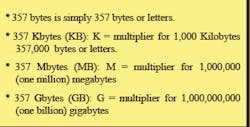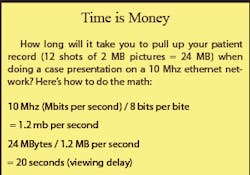Bits and bytes: Do the math!
What you don’t know can hurt you! So, here comes the knowledge doctor to make something that’s overwhelming, understandable to many people. What happens in the process of creating and distributing files? Have you considered this when using digital imaging? Are you providing an optimized network architecture with appropriate storage for your patients? Whether your eyes are already glazing over or your interest is sparked, this article will attempt to explore the basics of this topic.
Bits versus bytes ... and what does it hertz?
Computer storage, throughput, speed, and power specifications are stated using these terms. What do they mean? Computers can really be broken down to the simplest item - the bit. A bit is either on or off. On equals one and off equals zero. It takes eight of these little bits, grouped together, to represent the letters and numbers you see on a computer screen. This grouping of eight bits is then called a byte. So, one byte equals eight bits. Easy enough, right?
A (Ascii character) = 1 byte = 8 bits (wide) = 01000001 (binary) = 65 (decimal)
Notice the number of binary bits equals eight? If you have a Windows-based computer handy, you can right click on one of your files, choose properties, and the computer will show you the statistics on how many bytes make up that file. This is where many people get lost due to the abbreviated way computers report the number of bytes. The following bullets should help you get back on track:
The speed at which these bits are moved around inside the computer and over your network are shown in bps, or bits per second. In addition, these bits are moved over parallel paths on the computer’s “bus,” which provides an interconnection path for all the internal components to exchange bits and bytes with each other. Let’s say that your computer’s bus is 32 bits wide (which most of today’s “in-use” computers are). That means that 32 individual wires are designed into the computer’s bus for the specific purpose of transporting the data bits between the computer’s elements (disks, cpu, memory, display, printers, etc.) Since 8 bits = 1 byte, it can be extrapolated that this bus can move four bytes at any one time. That gets us to hertz, otherwise denoted as Hz.
Hertz is the unit of measurement for the number of cycles completed in one second. Thus, 60 Hz (the cycling speed of your AC power outlets on the wall) means “60 times per second.” The multiplier letters also are used with Hz. So, Khz means “kilohertz” (one thousand times per second), Mhz means “megahertz” (one million times per second), Ghz means “gigahertz” (1 billion times per second). To get an idea of the significance of the hertz, consider this: a 32-bit computer bus operating at 500 Mhz could move two billion bytes in one second; a 32-bit computer bus operating at 3 Ghz could move 12 billion bytes! It pays to know your hertz.
Of course, the discussion above is tremendously oversimplified for obvious reasons. The actual speed of the modern day PCI bus found in most computers is actually capped at around 3.8 Gbs, but the newer PCI-X bus (64 bits wide) is even faster and can be found in most newer machines.
What does this mean for your dental practice?
Let’s say you want to integrate digital-imaging technology into your practice and you have 2,000 patients. For each patient, you want the standard high quality extraoral shots for smile enhancement and case presentation. Each picture will be about two megabytes in standard mode, and up to 16 megabytes in fine mode. The individual picture size will vary depending on whether you are using a two megapixel camera or a five-megapixel camera (or somewhere in between).
Now do the math:
12 extraoral shots x 2 Mbytes x 2,000 patients = 24 Mbytes x 2,000 = 48 Gbytes for the average practice
If you don’t pay attention to individual picture size, you could wind up with eight MB pictures which would put you at 192 Gigabytes of storage used. It’s a good bet you won’t have the storage you’ll need in the long run if you don’t do the math and plan ahead.
As a final example of why the math is important, let’s look at the typical dental practice office network. Ninety percent of dental practice networks use 100 Mhz network cards. The older ones will use 10 Mhz, and some of the more tech savvy (10 percent of offices) will use a one GHz nic or Network Interface Cards (sometimes seen as 1Gbps).
Attach 10 workstations to a 10/100 network switch with 100 Mhz cards, and attach the server at the same speed (100 Mhz ethernet network card), and you “oversubscribe” your server by 90 percent. To balance the network and cut down on time-outs and transaction “retry,” you should attach the server at 1 Gbps and the workstations at 100 Mhz. Of course, you’ll need an appropriate network switch to do this.
Realistically, with the networking overhead, it’s going to be closer to 1 MB per second, so let’s just round it off and say 1 MB per second. This means you wait 24 seconds (minimum) to view all 12 photos. That assumes there’s no other traffic on the network and no other workstations are demanding something from the server. Twenty-four seconds will seem like an eternity in a treatment plan presentation.
Do the math and you’ll see that 24 seconds becomes 2.4 seconds with 100 Mhz cards and .24 seconds (2.4 tenths of a second = one-fourth of one second) with 1,000 Mhz cards (Gigabit Ethernet Adapters).
The kind of speed you’ll get with the right Ethernet cards, the right switch, and the right drives will make your case presentations smooth and enjoyable without technology delays.
By taking a hard look at how much storage capability you have now and how much you will use, you can accurately plan for the growth of your digital-imaging environment.
Don’t forget to calculate how long your backups will take. Look at the speed of your backup device. Do the math. An older tape drive (500 Kbytes per second) will take about 12 (or more) hours to backup 20 GB. You may need an upgrade!
Just do the math and remember that only the paranoid survive because only the paranoid seek the education they need to make wise decisions. What you are doing each day without considering timing, memory, and backup issues can bring you to a screeching halt at the most untimely moment.
Hopefully, this article will help you better understand bits, bytes, hertz, and more ... and will inspire you to seek professional coaching if you still feel overwhelmed about this topic and other technological issues.
David Redwine has more than 25 years of technology industry experience and currently serves as information technology manager and technology consultant at Jameson Management, Inc., an international dental practice-management consulting firm. He is a certified and experienced systems architect, network designer, systems administrator, and integrator. His broad experience with technologies helps him provide invaluable insight and guidance to JMI. Contact him by phone at (877) 369-5558, by e-mail at [email protected], or visit the Web site at www.jamesonmanagement.com.



